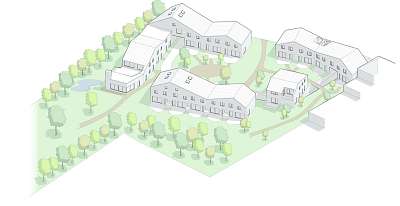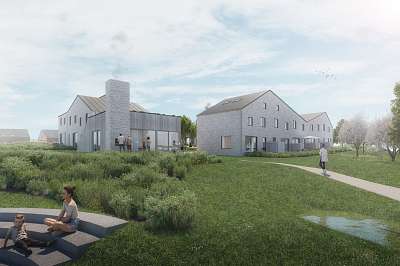This project is a response to decades of scattered building and subdivision.
The residential courtyard involves the transformation of the former dancing venue “Truweel” in Sint-Lievens-Esse. The site has a strong diagonal slope of about three meters across the 50-meter construction zone and extends 125 meters further into agricultural land. Due to numerous alterations over time, the existing buildings no longer hold any architectural value or potential for reuse. Together with the purchase of an adjacent plot, the site is being redeveloped into a residential courtyard with 18 units. Five residential blocks (two stories high under asymmetrical gable roofs) are arranged around a rectangular, green, low-traffic inner courtyard with a single entrance and exit.
A shared space of 72 m² is provided exclusively for residents (for birthday parties, community events, social activities such as workshops, card nights, or craft afternoons). This space connects to the garden and the surrounding landscape. The project includes 31 underground and 5 above-ground parking spaces, as well as an electric shared car. There are 66 bicycle parking spots, 12 of which are underground. The entire site remains open, transparent, and permeable, with a semi-public character. Green spaces and pathways are communal. Each unit has a large terrace that, while collectively owned, retains a private character.
The housing offer is diverse to encourage a social mix. Young families bring liveliness, while seniors keep a caring eye on the community. This diversity enhances livability and provides a dynamic boost to the village center of Sint-Lievens-Esse. The architecture reconciles the charm of the village with higher density, clustering buildings without neglecting the essence of village living.
The benefits of collective living extend beyond energy efficiency and economic advantages; they also address a shared social need for community. Shared economy and collective use are encouraged. A communal space is integrated for multipurpose activities such as celebrations, co-working, sports, and relaxation. Material sharing is also facilitated, allowing residents to share tools, garden equipment, or even a car. This reduces the need for each household to own its own shed, lawnmower, or second car. One trampoline, one large play structure, or a shared play landscape is enough to bring children together again in a safe neighborhood.











